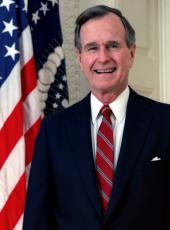To the Senate of the United States:
I transmit herewith, for the advice and consent of the Senate to ratification, the Treaty on Open Skies. I believe that the Treaty on Open Skies is in the best interest of the United States. By engaging all participating States actively in cooperative observation, the Treaty on Open Skies will strengthen international stability. The Treaty also provides an important means of increasing mutual understanding of military forces and activities, thus easing tensions and strengthening confidence and security, not only in the area covered by the Treaty, but in other areas as well.
The Treaty includes twelve Annexes, which are integral parts thereof. The Treaty, together with the Annexes, was signed at Helsinki on March 24, 1992. I transmit also, for the information of the Senate, the Report of the Department of State on the Treaty.
In addition, I transmit herewith, for the information of the Senate, five documents associated with, but not part of, the Treaty that are relevant to the Senate's consideration of the Treaty: Decision Number One on the Distribution of Costs Arising Under the Treaty on Open Skies in accordance with Annex L, Section I, paragraph 9, dated June 29, 1992; Decision Number Two on Additional Non-Destructive-Testing Equipment To Be Used by the Observed Party in accordance with Annex F, Section I, paragraph 7, dated June 29, 1992; Decision Number Three on Methodology For Calculating the Minimum Height Above Ground Level at Which Each Optical Camera Installed on an Observation Aircraft May Be Operated During an Observation Flight in accordance with Annex D, Appendix 1, Section III, paragraph 2, dated June 29, 1992; Decision Number Four on Minimum Camera Specification For an Observation Aircraft of an Observed Party Exercising its Right To Provide an Observation Aircraft For an Observation Flight, dated June 29, 1992; and Decision Number Five on Responsibility For the Processing of Film Used During an Observation Flight in accordance with Article IX, Section II, paragraph 2, dated June 29, 1992. Except for Decision Number One on the Distribution of Costs, these Decisions are legally binding.
The Decision on the Distribution of Costs Arising Under the Open Skies Treaty in accordance with Annex L, Section I, paragraph 9 has not been adopted by the Open Skies Consultative Commission (the implementing body of the Treaty made up of representatives from each State Party and the body which adopted the above-mentioned Decisions). The Open Skies Consultative Commission will adopt this Decision during its next session, scheduled for September 1992, and it will have the same legally binding status as the other Decisions. The Open Skies Consultative Commission has endorsed the current draft text of the Decision; however, agreement could not be reached on the issue of navigation fees which a great majority of the States Parties -- including the United States -- believe should be waived. Pending resolution of this issue, some States Parties -- including the United States -- have reserved their position on other cost issues.
The Open Skies Treaty establishes a regime of unarmed aerial observation flights over the entire territory of its 25 signatories (North Atlantic Treaty Organization Allies, Eastern European members of the former Warsaw Pact, and Russia, Ukraine, Belarus, and Georgia). The Treaty is designed to enhance mutual understanding and confidence by giving all participants, regardless of size, a direct role in observing military or other activities of concern to them. Covering territory from Vancouver to Vladivostok, Open Skies is the widest-ranging international effort to date to promote openness and transparency of military forces and activities. The Treaty allows for consensus decisions to improve sensors, to adjust quotas, and to admit new participants in order to enhance its effectiveness. The Open Skies principles may be applicable to States in other regions of the world as well.
The Treaty's operative provisions focus on four subjects:
-- Territory: The entire territory of all participants will be accessible to aerial observation. Whereas the former Soviet Union had insisted on closing areas for national security reasons, the Treaty provides that only flight safety considerations may restrict the conduct of observation flights.
-- Aircraft: Unarmed fixed-wing aircraft provided by either the observing or observed Party can be used. All Open Skies aircraft and sensors must pass specified certification and inspection procedures to ensure that they meet the standards of the Treaty.
-- Sensors: Open Skies aircraft may have video, panoramic and framing cameras for daylight photography, infra-red line scanners for a day/night capability, and synthetic aperture radar for a day/night all-weather capability. Photographic image quality will permit recognition of major military equipment, e.g., distinguishing a tank from a truck -- allowing significant transparency of military forces and activities. Sensor categories and capabilities can be improved by agreement among the States Parties. All equipment used in Open Skies must be commercially available to all participants. Data collected from the flights will be immediately shared by the observing and observed Parties, and may also be obtained by other States Parties.
-- Quotas: Loosely scaled to size, each State Party has agreed to an annual quota of observation flights it is willing to receive (42 for the United States and Russia/Belarus to 2 - 4 for the smallest States Parties). States Parties may conduct as many observation flights as they are willing to receive.
The Treaty establishes an Open Skies Consultative Commission, composed of representatives designated by each State Party, to meet in Vienna, to promote the objectives and to facilitate the implementation of the provisions of the Treaty.
Therefore, I urge the Senate to give early and favorable consideration to the Treaty and its related Annexes, and to give advice and consent to its ratification.
George Bush
The White House,
August 12, 1992.
George Bush, Message to the Senate Transmitting the Treaty on Open Skies Online by Gerhard Peters and John T. Woolley, The American Presidency Project https://www.presidency.ucsb.edu/node/266734

